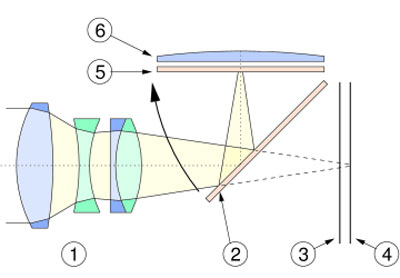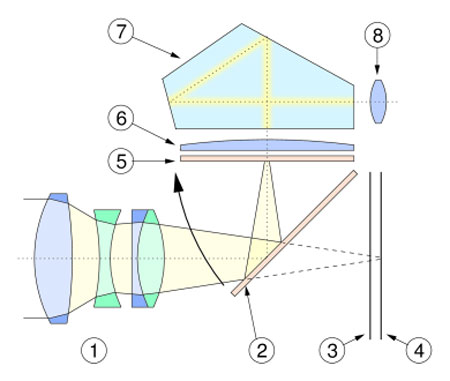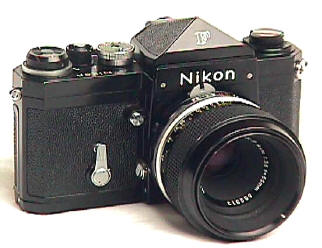Digital Photography from 20,000 Feet
by Wesley Fink on September 25, 2006 12:05 AM EST- Posted in
- Digital Camera
Why the Digital SLR?
SLR cameras have been around for more than 50 years, but it is remarkable how many of those shopping for a digital camera have no idea why the market is moving to the SLR or Single Lens Reflex. Up until the late 1940's the world of hobbyist photography was ruled by 35mm point-and-shoot and rangefinder cameras. These cameras were not really that different from the point-and-shoot cameras that we have today in digital photography, except that they did not have the benefit of all the electronics that are part of today's digital cameras. The cheap point-and-shoots used a fixed focus lens, which meant the lens always shot a certain range (depth-of-field) in focus - no matter whether the subject was in that range or not. The better of these cameras used rangefinders, which were two images from two optics superimposed in the viewfinder. When these two images merged in the viewfinder your subject was in focus. As you can imagine the optics to allow focusing were pretty complicated and expensive to build. However, with a fixed lens that never changed it was possible to design and manufacture some very reliable and affordable rangefinder cameras.
The top end of the amateur photography market, which had embraced 35mm as the "miniature" film standard, then introduced a brilliant idea. Why not manufacture cameras that could use multiple lenses. This would allow the photo hobbyist to use the lens that was best suited for what they were photographing - like a wide-angle lens for interiors, or a telephoto for sporting events and far away subjects. Companies like Leica and Contax pioneered these interchangeable lens rangefinder cameras in the 1930s. After World War II, German camera companies resumed camera manufacturing. Japan, which had manufactured quality optics for a more limited market before WWII, also began making quality interchangeable lens rangefinders. Japanese companies like Canon, Aries, and Nikon championed cameras with changeable lenses.
The ability to change lenses was a great idea, but the execution was anything but simple. Viewfinders started having multiple frames engraved for the different focal lengths like 35mm, 50mm, 85mm. The user had to remember that the tiny square was 85mm. Leica and others had accessory viewfinders that mounted on the flash shoe so you could see about what the lens saw. The problem with the rangefinder is that the viewfinder and the lens never see the same thing. This was not a huge issue with a fixed lens, since the viewfinder could be matched reasonably well to the lens. There were even complicated mechanics that adjusted the viewfinder for "parallax error" on rangefinder close-ups. But with interchangeable lenses the situation became very complicated.

The first popular solution to this problem was the German Exacta, fist produced in 1936. The Exacta had a waist level-finder and a flipping 45-degree mirror. With a flipping mirror, you could look through the lens for composition and focusing - seeing the same view as the lens. You looked at the image from above the camera (5), the image was backwards (as in a mirror image), and the mirror was either manually reset or later reset automatically when winding the film, but the view on the ground glass was the same as any lens (1) mounted on the camera.
In the 1950's the Japanese pioneered further development of the SLR design. A roof pentaprism first appeared on an East German Contax S announced in 1949, but the Japanese camera industry refined and perfected the idea. Asahi developed the Asahiflex in 1952, and in 1954 the Asahiflex IIB. In 1957, Asahi Pentax introduced the fixed pentaprism and the right-hand thumb wind lever. Minolta introduced their first SLR, the SR-2, in 1958. Nikon, Canon and Yashica introduced their first SLRs in 1959 (the F, Canonflex, and Pentamatic, respectively).

The diagram shows how the light passes through the SLR lens assembly (1), is reflected by the mirror (2) and projected on the matte focusing screen (5). Using a condensing lens (6) and internal reflections of the mirrored roof pentaprism (7) the image appears in the eyepiece (8). When an image is taken, the mirror flips up as the arrow indicates, the shutter (3) opens, and the image is projected onto the film or digital sensor (4) The image at the film or sensor is exactly the same as on the focusing screen. [Image from Wikipedia.]
By the early 1960s the basic form of the SLR had evolved to what we know today, as you can see in this photo of the original Nikon F SLR.

Refinements have continued to expand the usefulness of the SLR design. The Topcon RE Super and Asahi Pentax Spotmatic pioneered through the lens metering in the early 60's. Auto exposure was first seen in the Pentax Spotmatic F in 1971, and it was popularized with the Canon AE-1 Program in 1976. Pentax made a limited attempt at autofocus in 1981 with a 35-70 f2.8 lens for the Pentax ME-F. A few years later, Minolta brought out the first real autofocus camera, the MAXXUM 7000, in 1985. The autofocus auto-everything Maxxum 7000 was wildly popular and made autofocus a virtual requirement on future SLR designs.
SLR cameras have been around for more than 50 years, but it is remarkable how many of those shopping for a digital camera have no idea why the market is moving to the SLR or Single Lens Reflex. Up until the late 1940's the world of hobbyist photography was ruled by 35mm point-and-shoot and rangefinder cameras. These cameras were not really that different from the point-and-shoot cameras that we have today in digital photography, except that they did not have the benefit of all the electronics that are part of today's digital cameras. The cheap point-and-shoots used a fixed focus lens, which meant the lens always shot a certain range (depth-of-field) in focus - no matter whether the subject was in that range or not. The better of these cameras used rangefinders, which were two images from two optics superimposed in the viewfinder. When these two images merged in the viewfinder your subject was in focus. As you can imagine the optics to allow focusing were pretty complicated and expensive to build. However, with a fixed lens that never changed it was possible to design and manufacture some very reliable and affordable rangefinder cameras.
The top end of the amateur photography market, which had embraced 35mm as the "miniature" film standard, then introduced a brilliant idea. Why not manufacture cameras that could use multiple lenses. This would allow the photo hobbyist to use the lens that was best suited for what they were photographing - like a wide-angle lens for interiors, or a telephoto for sporting events and far away subjects. Companies like Leica and Contax pioneered these interchangeable lens rangefinder cameras in the 1930s. After World War II, German camera companies resumed camera manufacturing. Japan, which had manufactured quality optics for a more limited market before WWII, also began making quality interchangeable lens rangefinders. Japanese companies like Canon, Aries, and Nikon championed cameras with changeable lenses.
The ability to change lenses was a great idea, but the execution was anything but simple. Viewfinders started having multiple frames engraved for the different focal lengths like 35mm, 50mm, 85mm. The user had to remember that the tiny square was 85mm. Leica and others had accessory viewfinders that mounted on the flash shoe so you could see about what the lens saw. The problem with the rangefinder is that the viewfinder and the lens never see the same thing. This was not a huge issue with a fixed lens, since the viewfinder could be matched reasonably well to the lens. There were even complicated mechanics that adjusted the viewfinder for "parallax error" on rangefinder close-ups. But with interchangeable lenses the situation became very complicated.

The first popular solution to this problem was the German Exacta, fist produced in 1936. The Exacta had a waist level-finder and a flipping 45-degree mirror. With a flipping mirror, you could look through the lens for composition and focusing - seeing the same view as the lens. You looked at the image from above the camera (5), the image was backwards (as in a mirror image), and the mirror was either manually reset or later reset automatically when winding the film, but the view on the ground glass was the same as any lens (1) mounted on the camera.
In the 1950's the Japanese pioneered further development of the SLR design. A roof pentaprism first appeared on an East German Contax S announced in 1949, but the Japanese camera industry refined and perfected the idea. Asahi developed the Asahiflex in 1952, and in 1954 the Asahiflex IIB. In 1957, Asahi Pentax introduced the fixed pentaprism and the right-hand thumb wind lever. Minolta introduced their first SLR, the SR-2, in 1958. Nikon, Canon and Yashica introduced their first SLRs in 1959 (the F, Canonflex, and Pentamatic, respectively).

The diagram shows how the light passes through the SLR lens assembly (1), is reflected by the mirror (2) and projected on the matte focusing screen (5). Using a condensing lens (6) and internal reflections of the mirrored roof pentaprism (7) the image appears in the eyepiece (8). When an image is taken, the mirror flips up as the arrow indicates, the shutter (3) opens, and the image is projected onto the film or digital sensor (4) The image at the film or sensor is exactly the same as on the focusing screen. [Image from Wikipedia.]
By the early 1960s the basic form of the SLR had evolved to what we know today, as you can see in this photo of the original Nikon F SLR.

Refinements have continued to expand the usefulness of the SLR design. The Topcon RE Super and Asahi Pentax Spotmatic pioneered through the lens metering in the early 60's. Auto exposure was first seen in the Pentax Spotmatic F in 1971, and it was popularized with the Canon AE-1 Program in 1976. Pentax made a limited attempt at autofocus in 1981 with a 35-70 f2.8 lens for the Pentax ME-F. A few years later, Minolta brought out the first real autofocus camera, the MAXXUM 7000, in 1985. The autofocus auto-everything Maxxum 7000 was wildly popular and made autofocus a virtual requirement on future SLR designs.










81 Comments
View All Comments
feraltoad - Monday, September 25, 2006 - link
Is providing a single sentence regarding start-up time dwelling? I don't think any camera review is complete without listing startup times and listing shot to shot time. I think it's a bit hypocritical to focus on core architecture, timings and such and then say a length of time I can actually perceive is not relevant. Especially, when you go and provide such a good article. I think you are just trying to make the other review sites seem stodgy and backward or just wrongheaded, and show that AT is "with it". Moreover, you say they speak gibberish like they are jargon slinging photo elitist snobs. Then you provide,IMO, a pretty techical primer, when they probably have some material for novices too. I know you were just saying "We're Cool, We Rule!", but I don't think when ur AT you have to do that. AT is already in my RSS reader because it does quality reviews. I just skimmed the article, and I can't wait to go back and read it in depth. I'me really excited about AT doing photo stuff too. I agree with the above poster that finding some standard meaningful benchmarks with good subjective commentary will have AT ruling the roost in camera reviews. Not to plug another site, but I think Steve's Digicams provides excellent reviews, actually his site is about the only site I really find useful for cameras. I'm glad I will soon have two sites that provide good information. YAY AT!soydios - Monday, September 25, 2006 - link
How does AnandTech review and compare its computer components? With standardized benchmarks and editorial commentary. Compare all the cameras with a good, strong set of standardized tests across the board, and also add a dose of the editorial commentary.In particular, for the sub-$1000 market, I would suggest evaluating the kit as a whole (image quality with kit lens). Personally, I will be picking up a Nikon D50 with the 18-55mm and 55-200mm lenses, and I have researched the heck out of that package, trying to find an AnandTech-esque review.
Venturing above the sub-$1000 (although I would be very intrigued by some reviews of the professional-level equipment) would get very expensive very fast. Perhaps start small, then venture into the almost-pro market (Nikon D200 and Canon EOS 30D, and some of the $500-$1000 lenses), then maybe dip a toe into the professional level, just to let us all see what the real fancy stuff is like (since very few of us will be buying a D2Xs or EOS-1D MkII-N).
Time permitting, I would put out some quick looks at the Nikon D50 and the Canon EOS 350D, with some comparison between the two. A review/comparison of both the Nikon D80 (in the works, good!) and the Canon EOS 400D would be an interesting read.
Again, review the D-SLR market the same way you guys do computer hardware. Avoid the slugfest low-range and the stratospherically-priced high range. Focus on the high-midrange market (the sub-$1000 D-SLR's to start, move up to the $1k-2k market once you gain some feel for differences between cameras). Do across-the-board standardized benchmarks, with some synthetic but more real-world results.
mostlyprudent - Monday, September 25, 2006 - link
Exactly my thoughts. I have spent some time at a number of camera review sites and am always left wondering "Is the Nikon D80 good enough to justify the price difference over the D50?". "What about the Canon EOS 30D? How much better is it then the Nikon D80 or the Rebel XT/XTi?"Maybe these cannot be answered in the same way as CPU and GPU articles, but standardized tests and comparisons would be nice.
Give me some numbers! I don't want to hear "shot-to-shot performance was sluggish compared to higher end cameras"...unless you can quantify that for me.
Lighting is such an improtant part of photography. Standardized indoor lighting under a couple different kinds of lighting situation (i.e. low, bright, fluorescent, etc.). I don't know how to standardize outdoor shots, but it sure would be nice.
bigpow - Monday, September 25, 2006 - link
I'm gonna stick with www.dpreview.com for now if I want to get my digital photography news/articles.AT, stick with PCs, will you?
silver - Monday, September 25, 2006 - link
I don't understand as I usually read more than one site on one subject. For instance I've been reading Tomshardware since it was sysdoc.pair.com and both Anandtech and Extremetech nearly as long.jnmunsey - Monday, September 25, 2006 - link
Geez, you'd think a site like Anandtech would find someone who knows what he's talking about to write this article...soydios - Monday, September 25, 2006 - link
I'm just a photography hobbyist, but I thought that the article covered all the important basics of full-manual general photography and digital photography.I would touch on filters, though. Those can come in handy. Particular onces to focus on: UV ("does it actually do anything, or is it just a lens protector?" debate), Polarizing, and the primary colors (blue, yellow, and red).
soydios - Monday, September 25, 2006 - link
Concerning polarizing filters (I really wish there was an edit functionality for comments): circular polarizing works with autofocus and digital cameras, linear does not.I know AnandTech isn't much of a software website, but a short article on editing software (Adobe Photoshop, beta of Adobe Lightroom, Apple Aperture) would complete the picture. No need to focus on the software or printing, but a photography software article written in the same manner as this one is something that would help me a lot! (I have almost no experience with editing software).
Wesley Fink - Monday, September 25, 2006 - link
We all want to improve, so please provide specifics so we can address them. It would also be helpful if you would provide your photography credentials, so we can know the level of expertise to attach to your comments.kilkennycat - Monday, September 25, 2006 - link
... a first-class and technically-meaty summary of the current status of digital camera technology. Well up to the usual Anadtech standards. Congratulations, Wes. The addition of a Digital Camera section is a superb idea. By all means, use reference charts, lighting and scenes for resolution, optical-distortion, shading and color-fidelity comparison of both lenses and sensors. Just as you have with video cards and CPUs, come up with your own benchmarks if necessary.